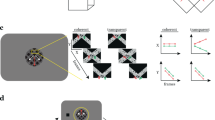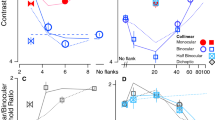Abstract
Human foveal vision is subserved initially by groups of spatial, temporal and orientational ‘filters’, the outputs of which are combined to define perceptual objects. Although a great deal is known about the filtering properties of individual cortical cells, relatively little is known about the nature of this ‘linking’ process. One recent approach1 has shown that the process can be thought of in terms of an association field whose strength is determined conjointly by the orientation and distance of the object. Here we describe a fundamental difference in this feature-linking process in central and peripheral parts of the visual field, which provides insight into the ways that foveal and peripheral visual perception differ2,3. In the fovea, performance can be explained only by intercellular linking operations whereas in the periphery intracellular filtering will suffice. This difference represents a substantial economy in cortical neuronal processing of peripheral visual information and may allow a recent theory of intercellular binding to be tested4,5,6,7.
This is a preview of subscription content, access via your institution
Access options
Subscribe to this journal
Receive 51 print issues and online access
$199.00 per year
only $3.90 per issue
Buy this article
- Purchase on Springer Link
- Instant access to full article PDF
Prices may be subject to local taxes which are calculated during checkout



Similar content being viewed by others
References
Field, D. J., Hayes, A. & Hess, R. F. Contour integration by the human visual system: evidence for a local “association field”. Vision Res. 33, 173–193 (1993).
Aubert, H. & Foerster, E. Unter suchungen über raumsinn der retina. Albrecht v. Graefes Arch. Opthalmol. 3, 1–37 (1857).
Schneider, G. E. Two visual systems. Science 163, 895–902 (1969).
von der Malsburg, C. in Synergetics of the Brain (ed. Basar, E., Flohr, H., Haken, H. & Mandall, A. J.) 238–249 (Springer, Berlin, (1983)).
von der Malsburg, C. & Singer, W. in Neurobiology of Neocortex (eds Rakic, P. & Singer, W.) 69–99 (Wiley, Chichester, (1988)).
Kreiter, A. K. & Singer, W. Global stimulus arrangement determines synchronization of neuronal activity in the awake macaque monkey. Eur. J. Neurosci. (suppl.) 7, 153 (1994).
Engel, A. K., Konig, P., Kreiter, A. K., Schillen, T. B. & Singer, W. Temporal coding in the visual cortex: new vistas on integration in the nervous system. Trends Neurosci. 15, 218–226 (1992).
Watt, R. J. & Morgan, M. J. Atheory of the primitive spatial code in human vision. Vis. Res. 25, 1661–1674 (1985).
Wang, Y., Thibos, L. N. & Bradley, A. Undersampling produces non-veridical motion perception, but not necessarily motion reversal, in peripheral vision. Vision Res. 36, 1737–1744 (1996).
Gilbert, C. D. & Wiesel, T. N. Columnar specificity of intrinsic horizontal and corticocortical connections in cat visual cortex. J. Neurosci. 9, 2432–2442 (1989).
Tso, D. Y. & Gilbert, C. D. The organization of chromatic and spatial interactions in the primate striate cortex. J. Neurosci. 8, 1712–1727 (1988).
Phillips, G. & Wilson, H. Orientation bandwidths of spatial mechanisms measured by masking. J. Opt. Soc. Am. 62, 226–232 (1983).
Watt, R. J. Understanding Vision (Academic, London, (1991)).
Acknowledgements
This work was supported by the Canadian MRC (MT 10818).
Author information
Authors and Affiliations
Corresponding author
Rights and permissions
About this article
Cite this article
Hess, R., Dakin, S. Absence of contour linking in peripheral vision. Nature 390, 602–604 (1997). https://doi.org/10.1038/37593
Received:
Accepted:
Published:
Issue Date:
DOI: https://doi.org/10.1038/37593
This article is cited by
-
Nearby contours abolish the binocular advantage
Scientific Reports (2021)
-
Co-circularity opponency in visual texture
Scientific Reports (2019)
-
The equivalent internal orientation and position noise for contour integration
Scientific Reports (2017)
-
Strong Bias Towards Analytic Perception in ASD Does not Necessarily Come at the Price of Impaired Integration Skills
Journal of Autism and Developmental Disorders (2015)
-
Impaired texture segregation but spared contour integration following damage to right posterior parietal cortex
Experimental Brain Research (2013)
Comments
By submitting a comment you agree to abide by our Terms and Community Guidelines. If you find something abusive or that does not comply with our terms or guidelines please flag it as inappropriate.



